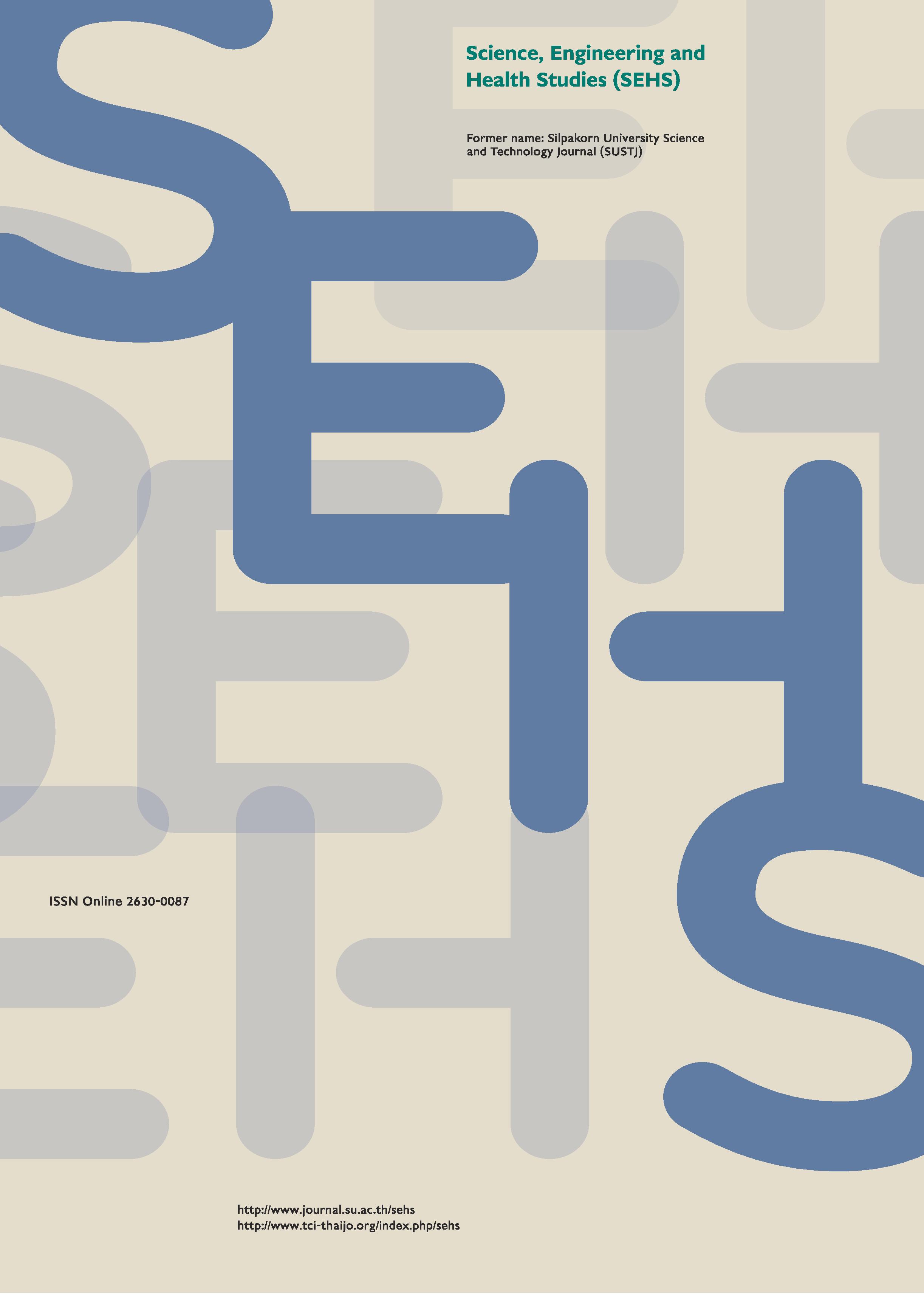In vitro characterization and viability of Vero cell lines supplemented with porcine follicular fluid proteins study
Main Article Content
Abstract
The purpose of this research was to study the morphological features of cells and test the porcine follicular fluid (pFF) supplements in Vero cell lines culture. The pFF in the estrous cycle was collected and kept sterile properly. The fluid was categorized into three types: small size (1-3 mm), medium size (4-6 mm) and large size (>7 mm) follicles. In the control group, Vero cell lines were cultured in dulbecco's modified eagle medium (DMEM). In the positive control group, Vero cell lines were cultured in DMEM and supplemented using 10% heat-treated fetal bovine serum (HTFBS). In the third group, Vero cell lines were cultured in DMEM and supplemented using pFF from small, medium and large sized ovarian follicles at 2, 4, 20, 40, 200, 400, 500 and 600 μg protein/mL concentrations for 24 h, using MTT assay. The results related to pFF from small-, medium- and large-sized follicles indicated that the percentage of cell viability in tested group at 400-600 µg protein/mL showed the percentage of viability came out to be the highest, significantly than that in the control group (p<0.05), and not different from that in the positive control group. In summary, according to morphological studies, the pFF effectively helped increase the growth of Vero cell lines closely as compared to the cultured group supplemented by HTFBS in the laboratory.
Downloads
Article Details
References
Ali, A., Coenen, K., Bousquet, D., and Sirard. M. A. (2004). Origin of bovine follicular fluid and its effect during in vitro maturation on the developmental competence of bovine oocytes. Theriogenology, 62(9), 1596-1606.
Ali, S., Ahmad, N., Akhtar, N., Zia-Ur-Rahman, and Noakes, D. E. (2008). Metabolite contents of blood serum and fluid from small and large sized follicles in dromedary camels during the peak and the low breeding seasons. Animal Reproduction Science, 108(3-4), 446-456.
Algriany, O., Bevers, M., Schoevers, E., Colenbrander, B., and Dieleman, S. (2004). Follicle size-dependent effects of sow follicular fluid on in vitro cumulus expansion, nuclear maturation and blastocyst formation of sow cumulus oocytes complexes. Theriogenology, 62(8), 1483-1497.
Ammerman, M. L., Fisk, J. C., and Read, L. K. (2008). gRNA/pre-mRNA annealing and RNA chaperone activities of RBP16. RNA, 14(6), 1069-1080.
Ayoub, M. A., and Hunter, A. G. (1993). Inhibitory effect of bovine follicular fluid on in vitro maturation of bovine oocytes. Journal of Dairy Science, 76(1), 95-100.
Brunner, D., Frank, J., and Appl, H. (2010). Serum-free cell culture: The serum-free media interactive online database. Alternatives to Animal Experimentation, 27(1), 53-62.
Ducolomb, Y., González-Márquez, H., Fierro, R., Jiménez, I., Casas, E., Flores, D., Bonilla, E., Salazar, Z., and Betancourt, M. (2013). Effect of porcine follicular fluid proteins and peptides on oocyte maturation and their subsequent effect on in vitro fertilization. Theriogenology, 79(6), 896-904.
Edwards, R. G. (1974). Follicular fluid. Journal of Reproduction and Fertility, 37(1), 189-219.
Genari, S., and Wada, M. (1995). Behavioural differences and cytogenetic analysis of a transformed cellular population derived from a Vero cell line. Cytobioas, 81(324), 17-25.
Hafez, E. (1992). Reproduction in farm animals, 3rd, Philadelphia, Lea & Feibiger.
Ito, M., Iwata, H., Kitagawa, M., Kon, Y., Kuwayama, T., and Monji, Y. (2008). Effect of follicular fluid collected from various diameter follicles on the progression of nuclear maturation and developmental competence of pig oocytes. Animal Reproduction Science, 106(3-4), 421-430.
Kor, N. M. (2014). The effect of corpus luteum on hormonal composition of follicular fluid from different sized follicles and their relationship to serum concentrations in dairy cows. Asian Pacific journal of tropical medicine, 7(suppl 1), S282-S288.
Ledwitz-Rigby, F., Rigby, B. W., Gay, V. L., Stetson, M., Young, J., and Channing, C. P. (1977). Inhibitory action of porcine follicular fluid upon granulosa cell luteinization in vitro: assay and influence of follicular maturation. Journal of Endocrinology, 74(2), 175-184.
Lowry, O., Rosebrough, N., Farr, A., and Randall, R. (1951). Protein Measurement with the folin phenol reagent. Journal of Biological Chemistry, 193(1), 265-275.
Mettasart, W. (2009). Cell and protein secretion from porcine oviduct and ovary in estrous cycle. (Master’s thesis), Silpakorn University, Sanam Chan Palace Campus, Nakhon Pathom, Thailand.
Oberlender, G., Murgas, L. D. S., Zangeronimo, M. G., da Silva, A. C., de Alcantara Menezes, T., Pontelo, T. P., and Vieira, L. A. (2013). Role of insulin-like growth factor-I and follicular fluid from ovarian follicles with different diameters on porcine oocyte maturation and fertilization in vitro. Theriogenology, 80(4), 319-327.
Romero-Arredondo, A., and Seidel, G. E. Jr. (1994). Effects of bovine follicular fluid on maturation of bovine oocytes. Theriogenology, 41(2), 383-394.
Suchanek, E., Simunic, V., Juretic, D., and Grizelj ,V. (1994). Follicular fluid contents of hyaluronic acid, follicle-stimulating hormone and steroids relative to the success of in vitro fertilization of human oocytes. Fertility and Sterility, 62(2), 347-352.
Swindle, M., Makin, A., Herron, A., Clubb, Jr. F., and Frazier, K. (2012). Swine as models in biomedical research and toxicology testing. Pharmaceutical Pathobiology, 49(2), 344-356.
Vatzias, G., and Hagen, D. R. (1999). Effects of porcine follicular fluid and oviduct-conditioned media on maturation and fertilization of porcine oocytes in vitro. Biology of Reproduction, 60(1), 42-48.
Youngsabanant-Areekijseree, M., Tungkasen, H., Srinark, C., and Chuen-Im, T. (2019). Determination of porcine oocyte and follicular fluid proteins from small, medium, and large follicles for used as cell biotechnology research. Songklanakarin Journal of Science and Technology, 41(1), 192-198.
Zhao, Ch., Hashiguchi, A., Kondoh, K., Du, W., Hata, J., and Yamada, T. (2002). Exogenous expression of heat shock protein 90 kDa retards the cell cycle and impairs the heat shock response. Experimental Cell Research, 275(2), 200-214.

